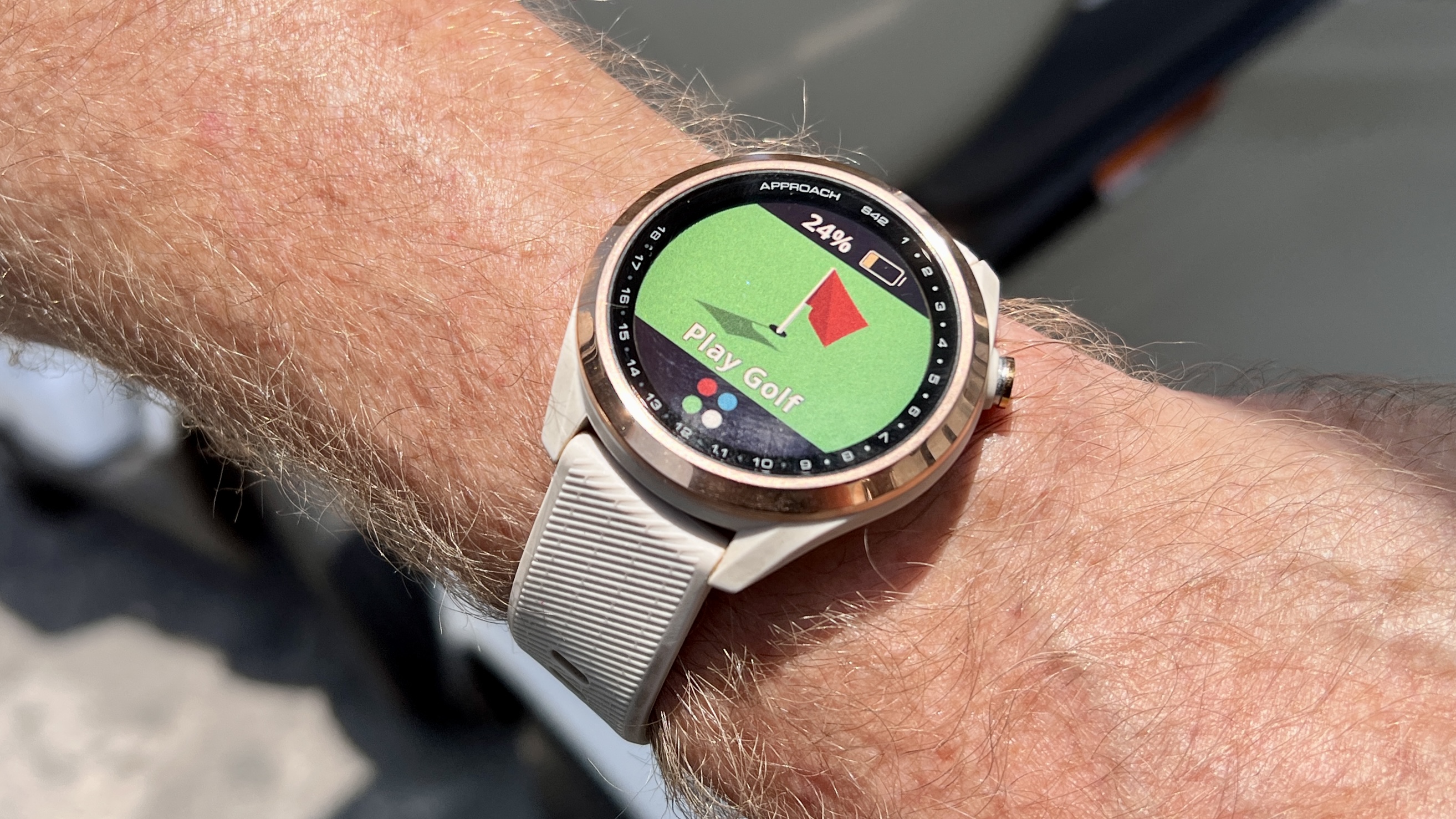Golf rangefinder vs. GPS watch — Which is right for you?
How to choose between a laser rangefinder and a GPS watch for golf

Golf tech is a passion of mine, but of all the gadgets out there, the two must-haves in my golf bag are my laser rangefinder and my GPS-enabled golf watch. I started playing golf long before either was available, and definitely I don't miss relying on vague 150 yards sticks and inconsistent sprinkler head markers to know how far I needed to hit my next shot.
But when it comes to a Golf rangefinder vs. GPS watch there are differences in the technology that could make one device better for your game than the other. Laser rangefinders work by firing a beam at a target, and measuring how long it takes to “rebound” back to the device. A GPS golf watch, meanwhile, tracks your location on a golf course to read yardages while providing a digital map of the hole (and its hazards) on your wrist.
Whether you’re not sure which to buy or which to use for your games, below are the pros and cons of laser rangefinders and GPS watches to help you choose where your golfing dollar is best spent.
Looking for more golf gear? We've found the best golf bags, the best golf gloves, and the best golf shoes here.
Golf laser rangefinder
A rangefinder’s rebounding laser is able to calculate the distance to a target in the device’s viewfinder based on the time it takes for the laser to travel to the target and back. Looking into the device, you can map out your next shot using the overlaid yardage information.
Early rangefinder models had several drawbacks — most were binocular-sized, needing two hands to operate properly. You’d struggle to hold the unit steady to get your target in the viewfinder and often end up not getting the reading to the intended target. Modern rangefinders are much more user-friendly thanks to magnified optics, internal LED displays, and automatic slop adjustments. Convenience features have also improved, such as smaller hand-held sizes and built-in magnets for mounting the rangefinder on your golf cart.

Available from brands like Bushnell, Blue Tees and Calloway, the price of rangefinder can start at $100 and go to as much as $600 or more. Higher costing models come with more of the features listed above, along with generally more distance capabilities and better accuracy. The Garmin Z82 Laser Rangefinder ($599 at Dick’s Sporting Goods) is one of the most advanced options, offering automatic course detection and full-color course mapping. If you’re looking for a beginner option, the Gogogo Sport Vpro Laser Rangefinder ($99 at Amazon) is a more budget-friendly choice.
Get instant access to breaking news, the hottest reviews, great deals and helpful tips.
GPS golf watch
First introduced over 10 years ago, advancements in golf watch technology has made these wearable devices a common sight on any course. What started as a simple LED yardage counter has transformed into an all-encompassing course manager. The market is dominated by Garmin, but even premium watchmakers such as Tag Heuer have thrown their hat in the ring.
Choosing the right golf watch for your game depends on price, style and functionality. Do you plan to wear it both on and off the course? And do you want it to double as a fitness tracker? Ultimately, how many features you will use and how much you’re willing to pay will provide a guideline for selecting a watch.

My personal watch of choice is the Garmin Approach S42 ($299 at Amazon), though Garmin has an ample collection of devices at different price points. These are some golf watch features you want to consider as you’re comparing devices:
- Smartphone connectivity: Being able to see mirrored texts, alerts and phone calls on my watch keeps things simple while I’m out on the green. I can leave my Apple Watch at home and my phone in my golf bag, only pulling it out for emergencies.
- Full-featured golf apps: Golf apps linking to both my smartphone and watch increases the functionality of my golf watch, giving me a more comprehensive view of the course and hazards I may not see. Garmin’s golf app is the gold standard.
- Great display: A large and sharp LED is essential for a golf watch. Even when facing direct sunlight, I need to be able to glance at my wrist quickly to see the information for my next shot.
- Golf course availability: Make sure the places you plan to play, whatever country that may be, are included in the pre-loaded database. That is becoming less of a problem these days, but be sure to check.
- Comfortable strap and size: Comfort and a proper fit is more important on a golf watch than on a normal timepiece, considering how integral the wrist is to your golf swing.
Golf rangefinder vs. GPS watch: Use cases
A laser rangefinder can be used quickly to see the exact distance to where the flag is placed on the green. A key advantage the rangefinder has over any GPS device is that you can get a custom reading that may not appear on your golf watch. For example, a golf watch knows the distance to permanent hazards at a hole, but only a rangefinder can tell you how far the group ahead of you is hanging out. I like using mine to see how far my drive went by standing backwards on the fairway while I’m next to my ball, measuring the tee box marker from that spot.
And though I was not an early adopter of golf watches due to inaccuracy concerns and cumbersome programming, using one now is as simple as taking it out of the box, charging it and going to the course. Improvements to GPS technology means accurate wrist readings, while new scorekeeping features, course maps (plus all the other smartwatch bells and whistles) make a golf watch a great accessory for the game.

Golf rangefinder vs. GPS watch: Which should you get?
If I had to choose to use either a laser ranger or a GPS watch, either for myself or as a gift for a new golfer, I would choose a watch. These are the advantages of a golf watch compared to a rangefinder that are most important.
More actionable information: While a rangefinder might tell you that you’re exactly 172 yards from the pin, the watch will tell you the distance to the front, middle and back of the green immediately. If a golfer knows they can hit it exactly 172 yards, that’s great for them. For average players and beginners, it's more important to know how to land safely within the entire range of the green.

Time savings: Pace of play is a hot topic in Pro golf lately, and it has always been an issue at both public and private courses alike. Even though you can get a quick reading on your rangefinder, you still have to take it on and off your cart between shots. The watch will give you distances to the green with just a glance at your wrist. No more than a press or two will get you the other readings like sand traps or water hazards, too. The only time lost, besides charging the watch between every few rounds, is for loading the course at the start of the round.
Multipurpose : No matter how much I like my rangefinder, it stays in my golf bag before and after every use. My watch, on the other hand, is a fully functional timepiece even when I’m not playing. Having it connected to my smartphone gives me something I can use for different purposes. Also, you will never lose your watch from your wrist. Ask any clubhouse attendant how many rangefinders get left in returned golf carts on a given day, by comparison.
More from Tom's Guide
- Garmin Approach S42 review
- I wore the Apple Watch Ultra for golf — here's what happened
- What is a golf handicap — and how do you calculate yours?

Jeff is a retired N.Y.C. firefighter who’s other two life passions are playing golf and telling people about golf. Jeff has spent forty years trying to perfect the unperfectable game, and hopes for forty more. Even if he’s failed at all attempts to train his labrador to retrieve golf balls chipped in the backyard.
When Jeff isn’t out trying to knock the last few strokes off his handicap at the course, you can find him in the gym or baseball diamond, doing all he can to keep Father Time at bay. Jeff lives in Long Island, New York where still uses his emergency training for the greater good.
